The first official economic growth statistics for all U.S. counties show which industries contributed to growth from region to region and in counties large, medium, and small across the nation.
These new Bureau of Economic Analysis statistics feature every county's gross domestic product – the value of goods and services produced within the county – and how much the inflation-adjusted GDP grew or decreased from the previous year. The statistics, for 2001 through 2018, also show industries' contributions to the change in each county's GDP.;
You can explore the data at GDP by County, Metro, and Other Areas on bea.gov and in BEA's Interactive Data Tables. GDP data also are available by metropolitan statistical area.
See the 10 fastest-growing counties in each region last year on our website. Here's a look at the growth leader among small counties (fewer than 100,000 people), medium counties (populations of 100,000 to 500,000), and large counties (more than 500,000) in each region:
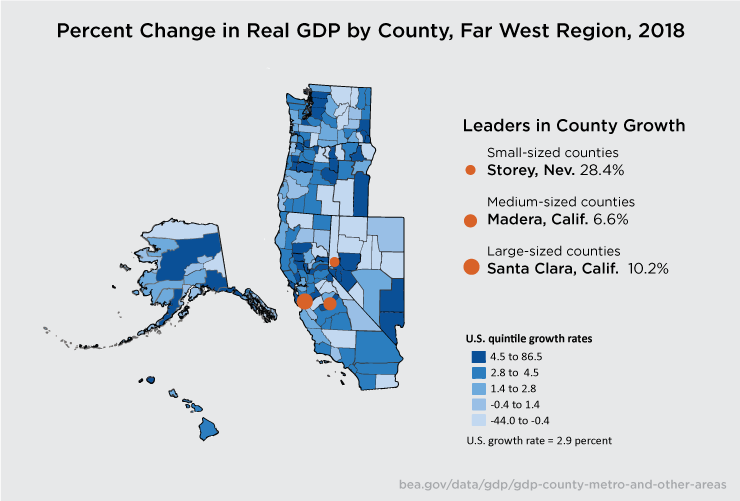
Storey County, Nev., led the Far West with GDP growth of 28.4 percent in 2018. Durable goods manufacturing was the leading contributor to this small county's growth.
Madera County, Calif., saw the fastest growth among the Far West's medium-sized counties, at 6.6 percent. The agriculture, forestry, fishing, and hunting industry was the top contributor to economic growth.
Santa Clara County, Calif., led not only the Far West but all large counties across the United States. The information industry was the leading contributor to the Santa Clara County economy's 10.2 percent growth.
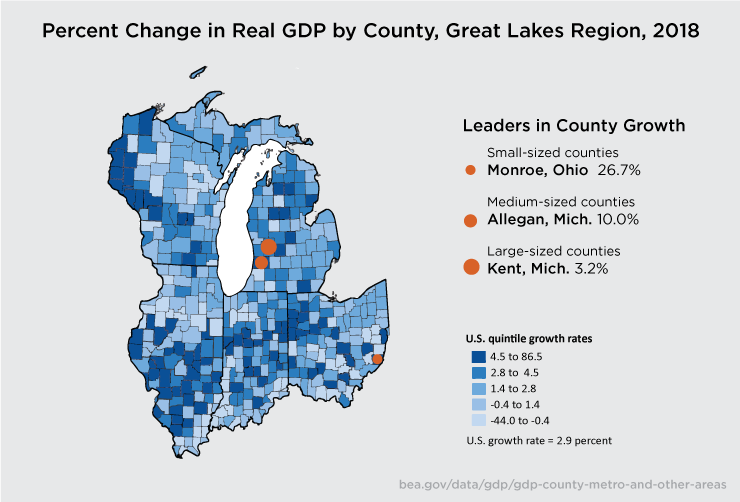
In the Great Lakes, the small county of Monroe, Ohio, had the fastest-growing economy, at 26.7 percent, with the largest contribution to GDP growth coming from mining, quarrying, and oil and gas extraction.
Allegan County, Mich., led the Great Lakes' medium-sized counties. Allegan County's economy grew 10.0 percent; the leading contributor was agriculture, forestry, fishing, and hunting.
Kent County, Mich., grew fastest among the region's large counties, at 3.2 percent, with durable goods manufacturing contributing most to the economic growth.
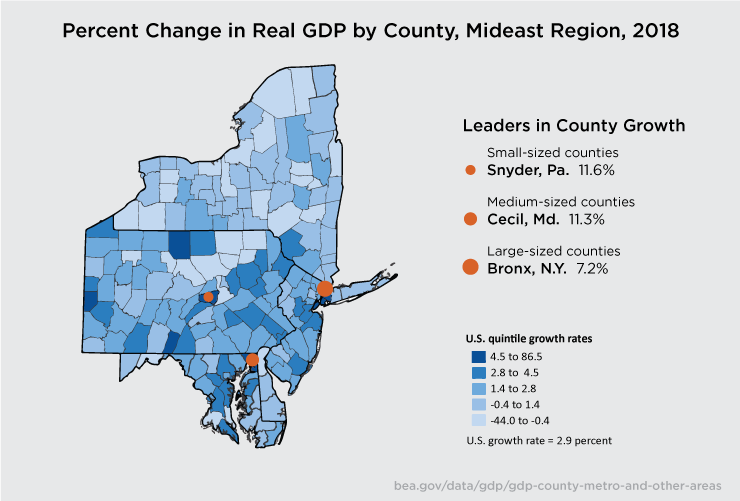
Snyder County, Pa., was the fastest-growing county economy in the Mideast, at 11.6 percent. Utilities led contributors to this small county's GDP growth.
Utilities were also the leading contributor to economic growth in Cecil County, Md., which led the Mideast's medium-sized counties at 11.3 percent.
The Bronx, in New York City, led large counties in the region, with 7.2 percent growth. The leading contributor was government and government enterprises.
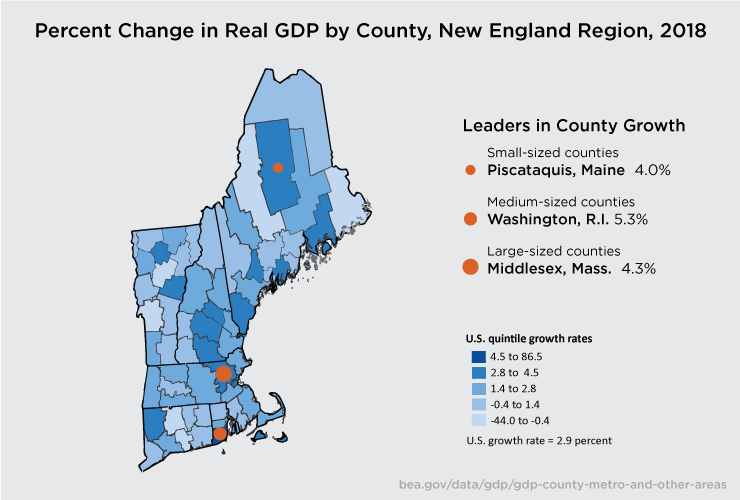
In New England, small-county growth was led by Piscataquis, Maine. Construction was the leading contributor to the Piscataquis County economy's 4.0 percent increase.
Medium-sized Washington County, R.I., led New England with economic growth of 5.3 percent; management of companies and enterprises was the leading contributor.
Among large counties, Middlesex County, Mass., topped the list. Professional, scientific, and technical services led the 4.3 percent GDP growth in this Boston-area county.

In the Plains, the economy of Harlan County, Neb., led the way with 71.2 percent growth. The agriculture, forestry, fishing, and hunting industry was the leading contributor to this small county's GDP increase.
Mining, quarrying, and oil and gas extraction made up the industry contributing most to the growth of St. Louis County, Minn. Its economy led the Plains Region's medium-size counties with 5.7 percent growth.
Sedgwick County, Kan., was the region's fastest-growing large-county economy, at 3.6 percent. Durable goods manufacturing was the leading contributor there.
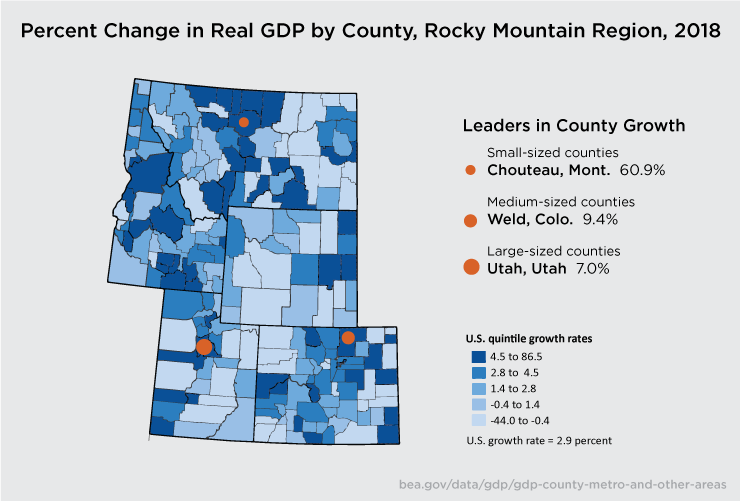
The small county of Chouteau, Mont., led the Rocky Mountain Region in economic growth at 60.9 percent. Its leading contributor was the agriculture, forestry, fishing, and hunting industry.
Weld County, Colo., led medium-sized Rocky Mountain counties with 9.4 percent economic growth; the leading contributor was mining, quarrying, and oil and gas extraction.
The region's fastest-growing large-county economy was Utah County, Utah, at 7.0 percent. The leading contributor was the industry of professional, scientific, and technical services.
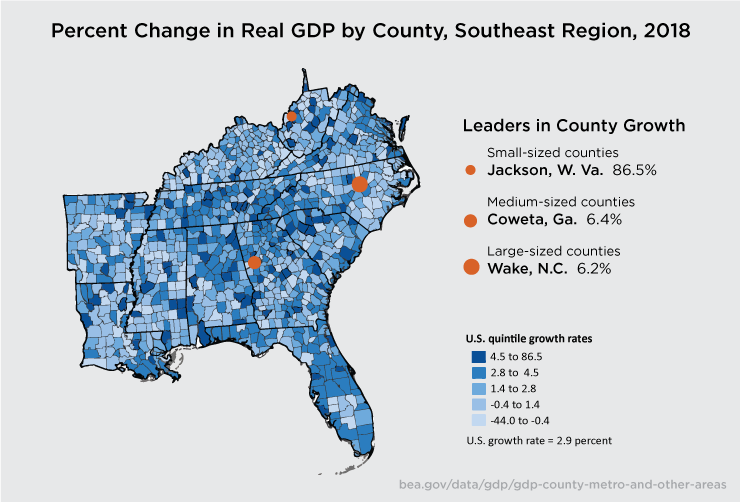
The Southeast was home to the United States' fastest-growing county economy of 2018: The small county of Jackson, W. Va., which grew 86.5 percent. Construction was Jackson County's leading contributor.
Coweta, Ga., led the Southeast's medium-sized counties with 6.4 percent GDP growth; its leading contributor was the health care and social assistance industry.
Wake County, N.C., logged the fastest economic growth among the Southeast's large counties, at 6.2 percent. Professional, scientific, and technical services led its contributing industries.
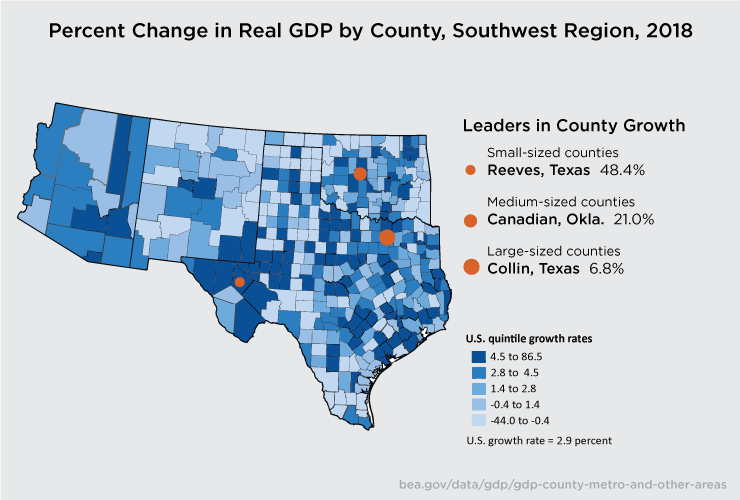
Growth in mining, quarrying, and oil and gas extraction was notable in the Southwest last year.
That industry (primarily oil and gas extraction and support activities) was the leading contributor to growth in Canadian, Okla., which had the fastest-growing economy among medium-sized counties in the United States. Its GDP grew 21.0 percent.
The industry also was the leading contributor to the 48.4 percent economic growth in Reeves County, Texas, the leader among the Southwest's small counties.
The finance and insurance industry was the leading contributor in the region's fastest-growing large county: Collin, Texas. Collin County's GDP increased by 6.8 percent.
Nationwide, the largest decrease in real, or inflation-adjusted, GDP in 2018 was -44.0 percent in Grant County, N.D. The size of county economies ranged from a real GDP of $18.4 million in Issaquena County, Miss., to $710.9 billion in Los Angeles County, Calif.
Find more GDP data for counties, metro areas, states, and the nation at bea.gov.